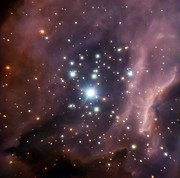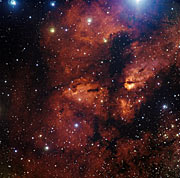Comunicato Stampa
Uno Sguardo alle Culle Infernali di Soli e Sistemi Solari
19 Agosto 2009
Le nuove immagini rilasciate oggi dall’ESO scavano nel cuore di una nebulosa cosmica, RCW 38, una regione affollata di stelle e sitemi planetari in fase di formazione. In questa zona, giovani stelle titaniche bombardano soli e pianeti appena nati con venti potenti e luce fiammeggiante. Stelle massiccie e dalla vita breve, che esplodono come supernovae le aiutano in questo compito devastante. In alcuni casi, questo attacco energetico ha modellato la materia che infine puo’ formare nuovi sistemi solari, Gli scienziati pensano che il nostro Sistema Solare sia emerso da un ambiente drammatico simile a questo.
Il denso ammasso stellare RCW 38 scintilla a circa 5500 anni luce di distanza, in direzione della costellazione della Vela. Cosi’ come l’ammasso dellla nebulosa di Orione (eso0113), RCW 38 e’ un “ammasso avvolto” nella nube di di polveri e gas da cui ha avuto origine. Gli astronomi hanno stabilito che la maggior parte delle stelle, incluse quelle di massa minore, rossastre, che superano in numero tutti gli altri tipi di stelle nell’Universo, hanno origine in queste regioni ricche di materia. Quindi gli ammassi avvolti sono per gli scienziati un laboratorio “vivente” in cui esplorare i meccanismi di formazione stellare e planetaria.
“Osservando ammassi stellari come RCW 38, possiamo imparare molto sulle origini del nostro Sistema Solare e di altri sistemi solari, nonche’ sull’origine di stelle e pianeti a venire”, ha commentato Kim DeRose, primo autore del nuovo studio pubblicato nell’ Astronomical Journal. DeRose ha lavorato su RCW 38 durante l’Universita’, quando era studente presso il Harvard-Smithsonian Center for Astrophysics, negli Stati Uniti.
Gli astronomi hanno usato lo strumento di ottica adattativa NACO, montato sul telescopio dell’ESO Very Large Telescope [1], per ottenere l’immagine piu’ nitida finora di RCW 38. Si sono concentrati su una piccola area al centro dell’ammasso, nei dintorni di una stella massiccia, IRS2, che brilla nello scottante intervallo bianco-blu, ovvero il colore e temperatura piu’ alti possibili per la superficie di una stella. Queste osservazioni drammatiche hanno rivelato che IRS2 non e’ una, ma due stelle – un sisitema binario costituito da due stelle gemelle caldissime., che distano una dall’altra circa 500 volte la distanza Terra-Sole.
In questa immagine ottenuta con NACO gli astronomi hanno trovato una manciata di protostelle – i fievoli precursori di stelle – e una dozzina di altre stelle che hanno a malapena svelato la propria presenza nonostante la potente luce ultravioletta irradiata da IRS2. Alcune di queste stelle in fase di gestazione non andranno oltre lo stadio di protostelle. La forte radiazione di IRS2 fornisce energia e disperde la materia che altrimenti collasserebbe in nuove stelle o che si e’ assestata in un cosidetto disco protoplanetario intorno alle stelle in fase di sviluppo. Nel corso di parecchi milioni di anni, il disco che sopravvive potrebbe portare a pianeti, stelle, lune e comete che possono costituire un sistema planetario come il nostro.
Se l’intensa radiazione ultravioletta non fosse sufficiente, queste affollate culle di stelle, come RCW 38, bombardano la propria nidiata con frequenti supernovae, il fenomeno che avviene quanto stelle molto grandi esplodono alla fine della loro vita. Queste esplosioni disperdono materia, inclusi rari isotopi –elementi chimici che sono creati all’interno di queste stelle morenti – in tutto lo spazio circostante. La materia esplusa diventera’ parte delle future generazioni di stelle che si formano nelle vicinanze. Poiche’ questi isotopi sono stati rilevati nel nostro Sole, gli scienziati hanno concluso che il Sole si e’ formato in un ammasso come RCW 38 piuttosto che in una zona piu’ rurale della Via Lattea.
“I dettagli di oggetti astronomici che si possono rivelare grazie all’ottica adattativa sono fondamentali per capire come nuove stelle e pianeti si formino in regioni complesse, caotiche, come RCW 38”, dice il co-autore Dieter Nürnberger.
Note
[1] ll nome NACO e’ la combinazione di Nasmyth Adaptive Optics System (NAOS) e Near-Infrared Imager and Spectrograph (CONICA). L’ottica adattativa elimina la maggior parte delle distorsioni di immagine dovute alla turbolenza nell’atmosfera della Terra causata da varazioni di temperatura e da venti.
Ulteriori Informazioni
Questi risultati sono stati pubblicati in un articolo sulla rivista specializzata Astronomical Journal: A Very Large Telescope / NACO study of star formation in the massive embedded cluster RCW 38, di DeRose et al. (2009, AJ, 138, 33-45).
Il gruppo di ricerca e’ composto da K.L. DeRose, T.L. Bourke, R.A. Gutermuth and S.J. Wolk (Harvard-Smithsonian Center for Astrophysics, Cambridge, USA), S.T. Megeath (Department of Physics and Astronomy, The University of Toledo, USA), J. Alves (Centro Astronómico Hispano Alemán, Almeria, Spain), e D. Nürnberger (ESO).
L’European Southern Observatory (ESO), è la principale organizzazione intergovernativa di Astronomia in Europa e il più produttivo osservatorio astronomico al mondo. È sostenuta da 14 Stati: Austria, Belgio, Repubblica Ceca, Danimarca, Francia, Finlandia, Germania, Italia, Paesi Bassi, Portogallo, Spagna, Svezia, Svizzera ed Inghilterra. L’ESO persegue un programma ambizioso, incentrato sulla progettazione, costruzione e operazione di potenti strutture osservative da Terra che permettono agli astronomi di ottenere importanti scoperte scientifiche. L’ESO svolge un ruolo di primo piano anche nel promuovere e organizzare cooperazioni nella ricerca astronomica. L’ESO gestisce tre dei migliori siti osservativi in Cile, unici al mondo: La Silla, Paranal e Chajnantor. Al Paranal, l’ESO gestisce il Very Large Telescope, l’osservatorio astronomico nella banda del visibile più avanzato al mondo. L’ESO è il partner europeo di ALMA, un telescopio astronomico rivoluzionario, il più grande progetto astronomico esistente. L’ESO sta attualmente pianificando un telescopio nel visibile e vicino infrarosso dal diametro di 42 metri, l’European Extremely Large Telescope, E-ELT, un telescopio che diventerà “il più grande occhio del mondo rivolto al cielo”.
Links
- Articolo scientifico: http://arxiv.org/abs/0904.3279 o http://www.iop.org/EJ/abstract/1538-3881/138/1/33/
- Pagina sull’ottica adattativa
- Pagina del VLT
Contatti
Dieter Nürnberger
ESO
Chile
Tel.: +56 2 463 3080
E-mail: dnuernbe@eso.org
Anna Wolter (press contact Italia)
Rete di divulgazione scientifica dell'ESO
e INAF-Osservatorio Astronomico di Brera
Milano, Italy
Tel.: +39 02 72320321
E-mail: eson-italy@eso.org
Sul Comunicato Stampa
| Comunicato Stampa N": | eso0929it |
| Legacy ID: | PR 29/09 |
| Nome: | RCW 38 |
| Tipo: | Milky Way : Star : Grouping : Cluster |
| Facility: | Very Large Telescope |
| Instruments: | NACO |
| Science data: | 2009AJ....138...33D |
Our use of Cookies
We use cookies that are essential for accessing our websites and using our services. We also use cookies to analyse, measure and improve our websites’ performance, to enable content sharing via social media and to display media content hosted on third-party platforms.
ESO Cookies Policy
The European Organisation for Astronomical Research in the Southern Hemisphere (ESO) is the pre-eminent intergovernmental science and technology organisation in astronomy. It carries out an ambitious programme focused on the design, construction and operation of powerful ground-based observing facilities for astronomy.
This Cookies Policy is intended to provide clarity by outlining the cookies used on the ESO public websites, their functions, the options you have for controlling them, and the ways you can contact us for additional details.
What are cookies?
Cookies are small pieces of data stored on your device by websites you visit. They serve various purposes, such as remembering login credentials and preferences and enhance your browsing experience.
Categories of cookies we use
Essential cookies (always active): These cookies are strictly necessary for the proper functioning of our website. Without these cookies, the website cannot operate correctly, and certain services, such as logging in or accessing secure areas, may not be available; because they are essential for the website’s operation, they cannot be disabled.
Functional Cookies: These cookies enhance your browsing experience by enabling additional features and personalization, such as remembering your preferences and settings. While not strictly necessary for the website to function, they improve usability and convenience; these cookies are only placed if you provide your consent.
Analytics cookies: These cookies collect information about how visitors interact with our website, such as which pages are visited most often and how users navigate the site. This data helps us improve website performance, optimize content, and enhance the user experience; these cookies are only placed if you provide your consent. We use the following analytics cookies.
Matomo Cookies:
This website uses Matomo (formerly Piwik), an open source software which enables the statistical analysis of website visits. Matomo uses cookies (text files) which are saved on your computer and which allow us to analyze how you use our website. The website user information generated by the cookies will only be saved on the servers of our IT Department. We use this information to analyze www.eso.org visits and to prepare reports on website activities. These data will not be disclosed to third parties.
On behalf of ESO, Matomo will use this information for the purpose of evaluating your use of the website, compiling reports on website activity and providing other services relating to website activity and internet usage.
Matomo cookies settings:
Additional Third-party cookies on ESO websites: some of our pages display content from external providers, e.g. YouTube.
Such third-party services are outside of ESO control and may, at any time, change their terms of service, use of cookies, etc.
YouTube: Some videos on the ESO website are embedded from ESO’s official YouTube channel. We have enabled YouTube’s privacy-enhanced mode, meaning that no cookies are set unless the user actively clicks on the video to play it. Additionally, in this mode, YouTube does not store any personally identifiable cookie data for embedded video playbacks. For more details, please refer to YouTube’s embedding videos information page.
Cookies can also be classified based on the following elements.
Regarding the domain, there are:
- First-party cookies, set by the website you are currently visiting. They are stored by the same domain that you are browsing and are used to enhance your experience on that site;
- Third-party cookies, set by a domain other than the one you are currently visiting.
As for their duration, cookies can be:
- Browser-session cookies, which are deleted when the user closes the browser;
- Stored cookies, which stay on the user's device for a predetermined period of time.
How to manage cookies
Cookie settings: You can modify your cookie choices for the ESO webpages at any time by clicking on the link Cookie settings at the bottom of any page.
In your browser: If you wish to delete cookies or instruct your browser to delete or block cookies by default, please visit the help pages of your browser:
Please be aware that if you delete or decline cookies, certain functionalities of our website may be not be available and your browsing experience may be affected.
You can set most browsers to prevent any cookies being placed on your device, but you may then have to manually adjust some preferences every time you visit a site/page. And some services and functionalities may not work properly at all (e.g. profile logging-in, shop check out).
Updates to the ESO Cookies Policy
The ESO Cookies Policy may be subject to future updates, which will be made available on this page.
Additional information
For any queries related to cookies, please contact: pdprATesoDOTorg.
As ESO public webpages are managed by our Department of Communication, your questions will be dealt with the support of the said Department.





